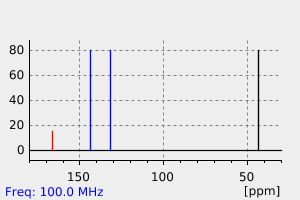(E)-3-(methylsulfonyl)-2-propenoic acid
中文名称
——
中文别名
——
英文名称
(E)-3-(methylsulfonyl)-2-propenoic acid
英文别名
(E)-3-(methylsulfonyl)acrylic acid;(E)-3-methylsulfonylprop-2-enoic Acid
CAS
——
化学式
C4H6O4S
mdl
——
分子量
150.155
InChiKey
KUKIFRWOPQFZKI-NSCUHMNNSA-N
BEILSTEIN
——
EINECS
——
-
物化性质
-
计算性质
-
ADMET
-
安全信息
-
SDS
-
制备方法与用途
-
上下游信息
-
文献信息
-
表征谱图
-
同类化合物
-
相关功能分类
-
相关结构分类
计算性质
-
辛醇/水分配系数(LogP):-0.7
-
重原子数:9
-
可旋转键数:2
-
环数:0.0
-
sp3杂化的碳原子比例:0.25
-
拓扑面积:79.8
-
氢给体数:1
-
氢受体数:4
上下游信息
-
上游原料
中文名称 英文名称 CAS号 化学式 分子量 (E)-3-(甲硫基)丙烯酸 (E)-3-(methylthio)acrylic acid 26398-93-6 C4H6O2S 118.156
反应信息
-
作为反应物:描述:肼基甲酸叔丁酯 、 (E)-3-(methylsulfonyl)-2-propenoic acid 在 N,N'-羰基二咪唑 作用下, 以 四氢呋喃 、 N,N-二甲基甲酰胺 为溶剂, 反应 0.5h, 以62%的产率得到tert-butyl (E)-2-(3-(methylsulfonyl)acryloyl)hydrazine-1-carboxylate参考文献:名称:Aza vinyl sulfones: Synthesis and evaluation as antiplasmodial agents摘要:A series of novel aza vinyl sulfones were designed, synthesized in good yields and evaluated as antiplasmodial agents. Tested compounds did not show activity against papain or the Plasmodium falciparum cysteine protease falcipain-2. However, a number of the new compounds effectively inhibited the in vitro development of P. falciparum. Compounds containing a squaramide group were the most active, with IC(50) values between 0.95 and 4.5 mu M, suggesting that these are potential lead compounds for the development of new antimalarial agents. (C) 2011 Elsevier Ltd. All rights reserved.DOI:10.1016/j.bmc.2011.10.018
-
作为产物:描述:参考文献:名称:Aza vinyl sulfones: Synthesis and evaluation as antiplasmodial agents摘要:A series of novel aza vinyl sulfones were designed, synthesized in good yields and evaluated as antiplasmodial agents. Tested compounds did not show activity against papain or the Plasmodium falciparum cysteine protease falcipain-2. However, a number of the new compounds effectively inhibited the in vitro development of P. falciparum. Compounds containing a squaramide group were the most active, with IC(50) values between 0.95 and 4.5 mu M, suggesting that these are potential lead compounds for the development of new antimalarial agents. (C) 2011 Elsevier Ltd. All rights reserved.DOI:10.1016/j.bmc.2011.10.018
文献信息
-
An Economical and Convenient Synthesis of Vinyl Sulfones作者:Yong-Min Liang、Zheng-Hui Guan、Wei Zuo、Lian-Biao Zhao、Zhi-Hui RenDOI:10.1055/s-2007-966039日期:——A general process for the efficient synthesis of vinyl sulfones has been developed using commercially available sulfinic acid sodium salts and dibromides. A variety of phenyl and methyl vinyl sulfones have been formed in good yields, in the absence of any catalyst.
-
Nrf2 Activating Compounds and Uses Thereof申请人:Rigel Pharmaceuticals, Inc.公开号:US20170217922A1公开(公告)日:2017-08-03Aspects of the present disclosure include compounds that activate Nrf2. Such compounds find use in the treatment of autoimmune and inflammatory diseases and disorders, such as for example psoriasis and multiple sclerosis. Embodiments of the present disclosure also relate to pharmaceutical compositions that include these compounds, methods of using these compounds in the treatment of various diseases and disorders, processes for preparing these compounds and intermediates useful in these processes.本公开涉及激活Nrf2的化合物,这些化合物可用于治疗自身免疫和炎症性疾病和疾患,例如牛皮癣和多发性硬化症。本公开实施例还涉及包括这些化合物的制药组合物,使用这些化合物治疗各种疾病和疾患的方法,制备这些化合物的过程以及这些过程中有用的中间体。
-
Synthesis of amides from Glycosmis species: Methylthiopropenoic acid, methylsulfonylpropenoic acid, thiocarbamic acid S-methyl ester, and senecioic acid amides作者:Sabine Hinterberger、Otmar Hofer、Harald GregerDOI:10.1016/s0040-4020(97)10297-6日期:1998.1Representative samples of several types of naturally occurring amides from south and southeast Asian Glycosmis species were synthesized for proof of structures and for bioactivity testing. With one exception (senecioic acid) all these amides were characterized by sulfur containing acid components (methylthiopropenoic acid methylsulfonylpropenoic acid and thiocarbamic acid) in combination with phenethylamine derived amino moieties. (C) 1997 Elsevier Science Ltd. All rights reserved.
-
Total synthesis and biological evaluation of methylgerambullone作者:Jong Taik Moon、Sung Hoon Ha、So Hyung Lee、Tae Hui Kwon、Chun Rim Oh、Young Deuk Kim、Jungahn Kim、Dong Joon Choo、Jae Yeol LeeDOI:10.1016/j.bmcl.2009.11.040日期:2010.1First total synthesis of methylgerambullone (MGB, 1) isolated from Glycosmis angustifolia was completed via a convergent route. The effect of MGB on the contractile responses of the isolated guinea-pig ileum induced by acetylcholine was investigated. As a result, it showed a potent relaxation rate (78.66 +/- 4.30% at 100 mg/L) in a concentration-dependent manner on longitudinal smooth muscle contraction of isolated guinea-pig ileum induced by 1 mu M acetylcholine. (C) 2009 Elsevier Ltd. All rights reserved.
表征谱图
-
氢谱1HNMR
-
质谱MS
-
碳谱13CNMR
-
红外IR
-
拉曼Raman
-
峰位数据
-
峰位匹配
-
表征信息
同类化合物
辛基甲烷硫代磺酸酯
辛基二砜
蚜灭多砜
蔊菜素
羟基十四烷磺酸钠
糖芥灵
磺酰基二乙睛
磺酰基二[三溴甲烷]
硫酸丙酯
硫酰二丙腈(SDPN)
硫甲磺酸钠
硫氰酸硫酯
硫杂环丁烷-3-羧酸1,1-二氧化物
硫杂环丁烷-1,1-二氧化物
砜吸磷
甲磺酰乙酸甲酯
甲磺酰乙酸
甲磺酰乙酮
甲烷磺酰基氰化物
甲烷磺酰基叠氮化物
甲烷磺酰基乙酸乙酯
甲烷硫代磺酸戊酯
甲烷硫代磺酸丁酯
甲烷硫代磺酸S-(三氯乙烯基)酯
甲烷硫代磺酸 S-(2-羟基乙基-1,1,2,2-D4)酯
甲基磺酰基甲胺
甲基磺酰基甲基磺酰基甲烷
甲基磺酰基甲基二硫基甲基磺酰基甲烷
甲基磺酰乙腈
甲基硫代磺酸甲酯
甲基癸基砜
甲基乙烯砜
甲基乙基砜
甲基3-(乙基磺酰基)丙酸酯
甲基-三聚乙二醇-砜-四聚乙二醇-炔基
环戊基磺酰基环己烷
环己烷,[[(三氟甲基)磺酰]乙炔基]-
环己基三氟甲基砜
环丙胺,N-[2-(2,4,5-三甲基苯氧基)乙基]-
特丁硫磷氧砜
烯丙基二甲基砜
炔基-四聚乙二醇-SULFONE-四聚乙二醇-羧酸
炔基-三聚乙二醇-SULFONE-三聚乙二醇-炔基
溴甲基甲烷硫代磺酸酯
涕灭砜威
氯甲基叔丁基砜
氯甲基三氯甲基砜
氯(甲磺酰基)甲烷
氯(甲磺酰基)乙烷
氯(氯甲基磺酰基)甲烷







